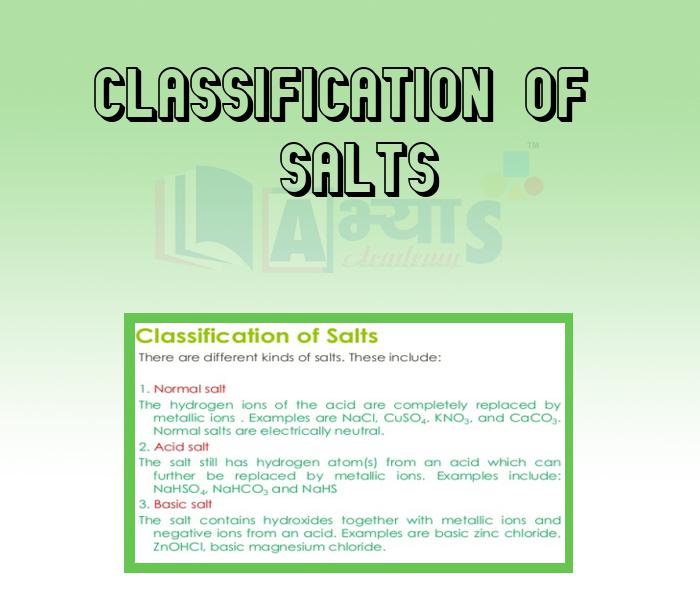Classification of Salts






Classification of Salts
Classification of Salts:
The different types of salts are: normal salt, acid salt, basic salt and double salt.
1. Neutral Salt: A salt that does not contain any replaceable hydrogen atoms or hydroxyl groups is called a normal salt. Example: Na2 SO4 obtained in the reaction between and NaOH is a normal salt because it is formed by the complete replacement of both the H atoms of
. Similarly, calcium sulphate
sodium phosphate (
) and potassium phosphate (
) are also normal salts.
2. Acid Salt: When an acid is not completely neutralized by a base, the salt produced will contain replaceable hydrogen atoms. Hence, it may further take part in the reaction with the base as an acid. Such a salt is called an acid salt. For example, the salt produced in the reaction between NaOH and
is an acid salt because it is capable of further reaction with the base NaOH to produce the normal salt
.
Thus, an acid salt may be defined as follows: A salt that contains replaceable hydrogen atoms is called an acid salt. Examples: and
are examples of acid salts.
3. Basic salt: When a base reacts with lesser amount of acid than, is necessary for complete neutralization, the salt produced contain hydroxyl group(s)(OH) also. Such a salt is called a basic salt.
Example: Pb(OH)Cl. These salts are called basic salts, because they can further react with the acids to form and the corresponding normal salts. Thus, a basic salt is formed when a base reacts with a lesser amount of an acid than is necessary for the formation of a normal salt
.

Double salt: In a double salt, there are two different negative ions and/or positive ions. For example, the mineral dolomite, ,
, contains both
and
ions. Hence, it is a double salt. Potash alum:
, also is a double salt. Double salts exist only in the solid state. When dissolved in water, they break up into a mixture of two separate salts. For example, when potash alum is dissolved in water, it breaks up as follows.

Salts formed by the reaction of strong acid with a strong base are called _____________ . | |||
| Right Option : B | |||
| View Explanation | |||
'Alum' is an example of ______________ | |||
| Right Option : B | |||
| View Explanation | |||
Salts formed by reaction of a strong acid and weak base are called ____________________ . | |||
| Right Option : C | |||
| View Explanation | |||
Students / Parents Reviews [20]
Abhyas is good institution and a innovative institute also. It is a good platform of beginners.Due to Abhyas,he has got knoweledge about reasoning and confidence.My son has improved his vocabulary because of Abhyas.Teacher have very friendly atmosphere also.

Manish Kumar
10thThe experience was nice. I studied here for three years and saw a tremendous change in myself. I started liking subjects like English and SST which earlier I ran from. Extra knowledge gave me confidence to overcome competitive exams. One of the best institutes for secondary education.

Aman Kumar Shrivastava
10thAbout Abhyas metholodology the teachers are very nice and hardworking toward students.The Centre Head Mrs Anu Sethi is also a brilliant teacher.Abhyas has taught me how to overcome problems and has always taken my doubts and suppoeted me.

Shreya Shrivastava
8thMy experience with Abhyas is very good. I have learnt many things here like vedic maths and reasoning also. Teachers here first take our doubts and then there are assignments to verify our weak points.

Shivam Rana
7thWhen I have not joined Abhyas Academy, my skills of solving maths problems were not clear. But, after joining it, my skills have been developed and my concepts of science and SST are very well. I also came to know about other subjects such as vedic maths and reasoning.

Sharandeep Singh
7thIt has a great methodology. Students here can get analysis to their test quickly.We can learn easily through PPTs and the testing methods are good. We know that where we have to practice

Barkha Arora
10thThird consective year,my ward is in Abhyas with nice experience of admin and transport support.Educational standard of the institute recumbent at satisfactory level. One thing would live to bring in notice that last year study books was distributed after half of the session was over,though study ...

Ayan Ghosh
8thAbhyas institute is one of the best coaching institute in the vicinity of Ambala cantt.The institute provides good and quality education to the students.The teachers are well experienced and are very helpful in solving the problems. The major advantages of the institute is extra classes for weak...

Shreya Shrivastava
8thMy experience with Abhyas academy is very good. I did not think that my every subject coming here will be so strong. The main thing is that the online tests had made me learn here more things.

Hiya Gupta
8thIn terms of methodology I want to say that institute provides expert guidence and results oriented monitering supplements by requsite study material along with regular tests which help the students to improve their education skills.The techniques of providing education helps the students to asses...

Aman Kumar Shrivastava
10thAbhyas institute is one of the best coaching institute in the vicinity of Ambala Cantt area. The teachers of the institute are well experienced and very helpful in solving the problems of the students.The good thing of the institute is that it is providing extra classes for the students who are w...

Aman Kumar Shrivastava
10thOne of the best institutes to develope a child interest in studies.Provides SST and English knowledge also unlike other institutes. Teachers are co operative and friendly online tests andPPT develope practical knowledge also.

Aman Kumar Shrivastava
10thAbhyas is an institute of high repute. Yogansh has taken admission last year. It creates abilities in child to prepare for competitive exams. Students are motivated by living prizes on basis of performance in Abhyas exams. He is satisfied with institute.

Yogansh Nyasi
7thWe started with lot of hope that Abhyas will help in better understnding of complex topics of highers classes. we are not disappointed with the progress our child has made after attending Abhyas. Though need to mention that we expected a lot more. On a scale of 1-10, we would give may be 7.

Manya
8thMy experience with Abhyas academy is very nice or it can be said wonderful. I have been studying here from seven class. I have been completing my journey of three years. I am tinking that I should join Abhyas Academy in tenth class as I am seeing much improvement in Maths and English

Hridey Preet
9thAbhyas is a complete education Institute. Here extreme care is taken by teacher with the help of regular exam. Extra classes also conducted by the institute, if the student is weak.

Om Umang
10thA marvelous experience with Abhyas. I am glad to share that my ward has achieved more than enough at the Ambala ABHYAS centre. Years have passed on and more and more he has gained. May the centre flourish and develop day by day by the grace of God.

Archit Segal
7thIt was a good experience with Abhyas Academy. I even faced problems in starting but slowly and steadily overcomed. Especially reasoning classes helped me a lot.

Cheshta
10thAbhyas Methodology is very good. It is based on according to student and each child manages accordingly to its properly. Methodology has improved the abilities of students to shine them in future.

Manish Kumar
10thIt was good as the experience because as we had come here we had been improved in a such envirnment created here.Extra is taught which is beneficial for future.
